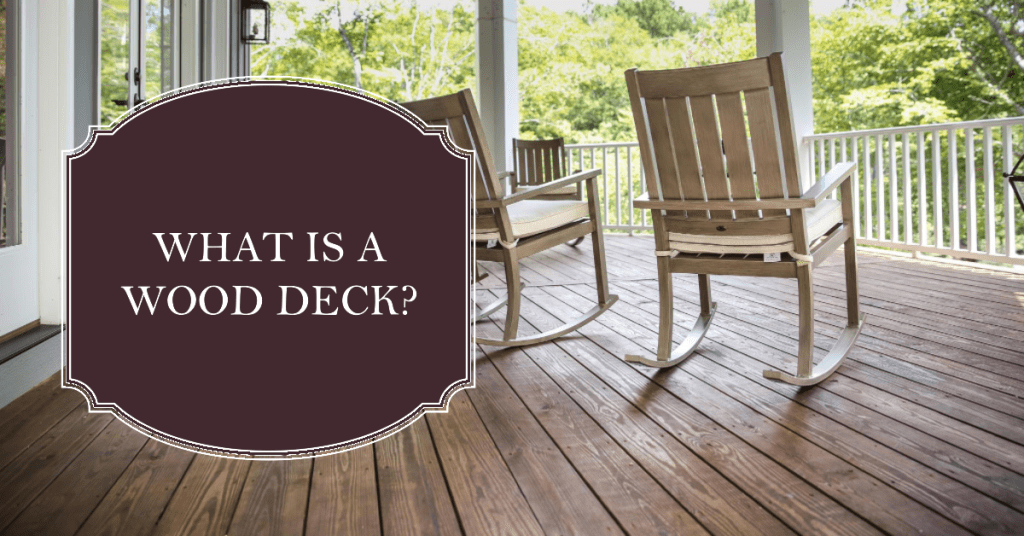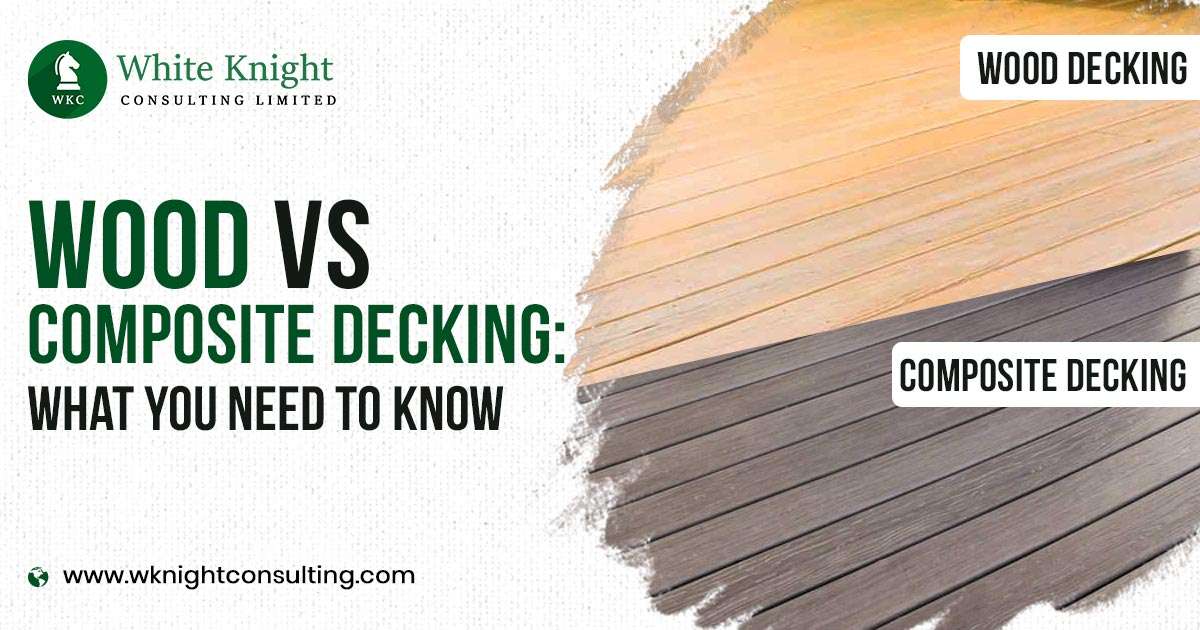Unlike traditional times when wood was the only available option for someone looking to build a deck, there are now plenty of alternative decking types available that may or may not be better than wood decking. These include hardwood, softwood, engineered wood, pressure-treated timber, composite decking, etc.
Wood and composite are two of the most common and popular decking choices today. Both options offer great variety and flexibility and can be used in a range of conditions.
If you’re not sure which type of decking would work best for you or are confused between wood vs composite decking, here’s everything you need to know about the many benefits and features of a composite deck and a wood one and the differences between them.
What is a Wood Deck?

You may already be familiar with the concept of a deck. It’s a custom-built area right outside a house or building, usually overlooking a garden, where people can sit and relax.
When it comes to decks, choosing the best wood for decking is essential. Whether you opt for hardwood or softwood, your wood deck should be resistant to decay and insect attack, especially considering its exposure to sunlight and the elements. In cases where the lumber isn’t naturally durable, pressure treatment is a common practice before using it for decking.
What’s a Pressure-Treated Wood Deck?
Solid wood which is not naturally durable or resistant to decay and insects is often pressure-treated before it’s used to build a deck. It involves treating the lumber with high temperature, pressure and/or chemicals which helps reduce moisture and enhance its durability permanently.
What’s a Composite Deck?
A composite is a type of manufactured material which is made by combining two or more products. This helps enhance the natural properties and features of each material.
For decking, wood plastic composite (WPC) is the most commonly used composite product. It is made by combining real wood with high-quality plastic to form an even stronger material that is resistant to rot, insects and damage.
Composite decks can be made to imitate real lumber, giving the natural aesthetic and feel of a solid wood deck. They are usually cheaper, more durable, accessible and versatile than wood decks.
Solid Wood Decking Pros & Cons
Pros:
Solid wood has always been a preferred option for an exterior deck. This is because wood being a natural material gives a familiar feeling when used outside along with gardens or lawns. Many people find the natural appearance of a lumber deck soothing and comforting and love the feel of timber under their feet.
Wood decking can also be seamlessly stained, finished or coloured to achieve the desired look, whilst composite cannot be finished or coloured later.
Many wood species used for decking are naturally durable and can resist a variety of insects and will not decay easily. Real wood decks are known to survive decades with good maintenance.
Another advantage of wood decking over composite decking is that treated softwood decks are usually cheaper than composite decks because softwoods are less expensive and easily available. They can be treated to enhance durability and make them fire-resistant.
Solid wood decking is also usually easier to install than a composite deck. Timber boards can be easily laid in any formation.
Cons:
Wood can start decaying, warping and splintering due to exposure to harsh weather.
Almost all kinds of solid lumber need to be pressure-treated to enhance their durability and make them resistant to rotting and insect attack before they can be used for decking. This can add to the cost.
Solid timber decking needs significant maintenance because the wood will ultimately start deteriorating, losing its finish and charm, or getting scratches and dents. The colour might turn grey over time if not stained. It must be properly cared for with regular stripping, treating, finishing, staining and washing to maintain its appearance and value.
Unlike composite or man-made decks, solid wood decks are not flawless in terms of appearance. They may have knots and other defects of natural lumber.
They tend to be more slippery than composite decks, especially when wet.
Softwood decking, which is cheaper than composite decking, is also less durable and is not the best option for places with heavy footfall. Durable hardwood decking is usually more expensive than composite decking.
Composite Decking Pros & Cons
Pros:
When compared to timber decks, composite decking offers many obvious advantages, such as:
Better durability: Composite wood decks are usually stronger and more durable than natural wood decks. They are also resistant to rot, warp, shrinkage or splinter, making them a superior choice for high-traffic areas.
Insect Resistant: They are made to be resistant to common insects and pests and will not be easily penetrated.
Water Resistant: Thanks to the plastic component in a composite deck, water is not easily absorbed in it, which keeps the deck safe from decay and rot for a very long time.
Variety of Designs: One of the benefits of composite decking is that it comes in a large variety of colour and design options, unlike wood decking which comes in limited colour options.
Wood Aesthetic: Modern composite decks are made to give the appearance of wood and may even feature a wood-like texture to give the feel of real lumber.
Low Maintenance: Unlike wooden decking, composite decks require minimal maintenance and can do with simple cleaning. They do not break or damage as easily as a solid wood deck.
Sustainable: Because most of the composite decking available today is made using recycled materials, it’s an environmentally friendly decking option.
Cons:
There may be some disadvantages to composite wood decking, such as:
Lack of natural feel: No matter how well a composite deck has been designed, it’s still a man-made product and may lack the natural feel or appearance of wood, which many people prefer more. Also, the colours once done are permanent.
Prone to scratches: It may catch scratches easily, though it’s resistant to dents. Also, it’s more difficult to repair than wooden decks.
Fades over time: The colour of a composite deck may fade over time when constantly exposed to sunlight, which may cause your deck to look not so appealing after some years.
Lower ROI: Composite decking typically gives a lower return on investment than wooden decking. So, if you ever need to sell your house, you may not get a good monetary value for your composite deck.
Wood vs Composite Decking Cost
The cost of a deck is calculated by combining the cost of raw materials and the time and cost of installation.
The cost of wood and composite decks can vary greatly depending on the type, raw material, and installation time.
In general, a wood deck might cost more than a composite deck because many popular & durable hardwoods favoured for decking such as Ipe, Redwood, Oak, and Red Cedar have limited availability and high cost. This problem can, however, be solved by using low-cost softwoods such as pine and fir, which can be pressure treated to enhance their durability and rot resistance.
Many pressure-treated wood decks cost (around $30-$50 per sq m) less than a customised composite deck, which can cost as much as $60-$100 per square metre, depending on your location.
When comparing the cost of wood vs. composite deck, you must also consider the maintenance cost, which can be significantly higher for a solid wood deck, which requires constant maintenance and care.
Composite vs Wood Decking: Which is Better?
In terms of materialistic advantages, composite decking obviously beats solid lumber decking. It is more durable and versatile and needs less maintenance than a wood deck.
However, if you desire the natural warmth and feel of real lumber, nothing can beat a solid timber deck.
Composite decks need to be maintained less than wood decks, which must be adequately looked after to maintain their beauty for a long time. Wood decking might also be prone to damage by mould and rot.
The important thing to note is that a composite deck is also a type of deck that contains wood with other materials like plastic to make it better and more efficient.
Whichever type of deck you choose, if you need high-quality, sustainable solid wood, hardwood or softwood in bulk at the lowest price with doorstep delivery to your location, contact White Knight Consulting Ltd. We are an FSC-certified timber manufacturer, supplier and exporter based in the UK.
